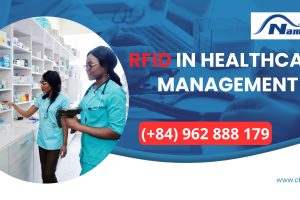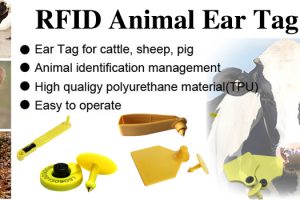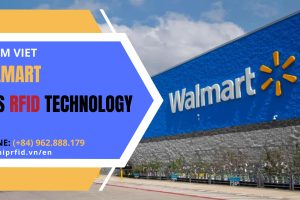Currently, RFID has been widely applied in almost all fields, from transportation, inventory management, retail to RFID in healthcare, and more. There are many types of RFID tags on the market, among which, the two most commonly used are HF RFID tags and UHF RFID tags. HF operates at 13.56 MHz, while UHF operates in the range of 860-960 MHz. This frequency difference affects their range, anti-interference capabilities, and tag size. So, which is better, HF RFID or UHF RFID chips? The detailed information below will help you answer this question.
Overview of HF RFID and UHF RFID Chips
RFID, or Radio-Frequency Identification, is a technology that uses electromagnetic fields to identify and track objects equipped with RFID tags. Based on the operating frequency band, RFID systems are divided into three frequency bands: Low Frequency (LF), High Frequency (HF), and Ultra-High Frequency (UHF). Among these, HF and UHF are the two most common frequency bands, applied in many areas of life.
About RFID Chips
An RFID chip is an integrated circuit embedded within an RFID tag or label, serving as the “brain” of the entire RFID system. It functions to store information, including product identification codes, product details, or sensor data of the object; and to communicate with an RFID reader for data transmission.
An RFID chip consists of three parts:
- A transceiver including an antenna and impedance matching circuit to receive signals from the RFID reader.
- Data storage memory with partitions such as Reserved Memory, EPC (Electronic Product Code), TID (Tag Identifier), and User Memory.
- A control unit that processes signals and manages the chip’s operation.
About HF RFID (High Frequency)
The operating frequency of High-Frequency RFID is typically 13.56MHz. This is an extended frequency range with anti-interference capabilities in liquid and metal environments. HF tags are commonly used in contactless payments, electronic ticketing, access control, and educational applications such as RFID in library management.
About UHF RFID (Ultra-High Frequency)
Accordingly, the operating frequency range of UHF RFID is between 860 – 960MHz, with a longer reading distance and faster data transmission speed. It is known that UHF (Ultra-High Frequency) RFID uses long-range field communication technology, enabling data transmission at distances from a few meters to tens of meters. UHF tags are commonly used in RFID supply chain management, inventory control, vehicle tracking, and automated merchandise management systems.
Comparison of HF RFID and UHF RFID
HF RFID chips and UHF RFID chips share similarities and differences. Accordingly, chips of these two frequency types are used in many different fields such as warehouse management, goods tracking, access control, etc. However, in addition to the fundamental difference in operating frequency range, there are many other differences between them, specifically detailed in the comparison table below:
| Comparison Criteria | HF RFID Chip | UHF RFID Chip |
|---|---|---|
| Operating Frequency | 13.56MHz | 860 – 960MHz |
| Reading Range | Short distance, usually from 10cm to 1 meter | Long reading distance, from 1 to 12 meters, possibly further depending on the reader and environment |
| Reading Speed | Slower reading speed compared to UHF RFID | Fastest reading speed compared to HF and LF RFID |
| Cost | HF RFID tags are usually smaller and more expensive than UHF tags | UHF RFID is usually more affordable compared to HF RFID |
| Tag Processing Capability | Lower tag processing capability | UHF RFID systems have a better capability to process multiple tags simultaneously |
| Applications | HF tags are commonly used in contactless payments, electronic ticketing, access control, and educational applications such as library cards. | UHF tags are commonly used in supply chain management, inventory control, vehicle tracking, and automated merchandise management systems. |
So, Which is Better, HF RFID or UHF RFID?
As analyzed, whether HF RFID or UHF RFID is better depends on many factors, including: specific application, usage environment, investment budget, etc.
- Accordingly, HF RFID is often used for applications that require high security, the ability to read through thick materials, and short-range communication, such as NFC payments, access control, etc. Meanwhile, UHF RFID is commonly used in warehouse management, goods tracking, with a long reading range, fast reading speed, and relatively lower cost.
- On the other hand, HF RFID is generally considered less susceptible to interference from metals and liquids, making it suitable for various environmental conditions. In contrast, UHF RFID is more vulnerable to metal or liquid environments.
- In terms of cost, HF RFID is more expensive than UHF RFID.
Therefore, IT Nam Viet finds it difficult to definitively say which RFID chip is the best. We will provide the most accurate advice to our customers based on specific needs. For example, in library operation management, we still recommend using HF RFID chips to enhance security and easily control books. However, in the case of RFID applications for non-stop toll collection, we recommend using UHF RFID chips.
Guide to Choosing the Right RFID Chip
Choosing the right HF RFID or UHF RFID chip is a crucial factor that helps businesses, units, and organizations ensure optimal operational efficiency. When choosing RFID chips, you need to consider the following basic factors:
- Clearly define the purpose of using RFID, the requirements for reading range, reading speed, security, etc. From there, the RFID technology provider will help you choose the appropriate RFID chip.
- Consider the operating environment, metals, liquids, etc.
- Consider the investment budget, ensuring the best balance between efficiency and cost.
- Ideally, you should research and listen to advice from experts and professional service providers to choose the RFID chip that suits your needs.
IT Nam Viet – A Provider of Diverse, High-Quality RFID Cards
IT Nam Viet is proud to be one of the pioneering units in the RFID field in Vietnam. We have over 10+ years of experience, with a team of professional technicians, well-trained from top universities across the country. We are committed to providing customers with optimal service, genuine products, at the most reasonable prices.
Thus, the choice between HF RFID and UHF RFID depends on needs, budget, operating environment conditions, etc. Understanding the differences between each RFID chip will help you make the right choice, thereby deploying an RFID system that suits your requirements.
When you come to IT Nam Viet, your business will receive dedicated and attentive support with the highest sense of responsibility, 24/7. We provide various types of RFID cards, including LF cards, HF cards, UHF cards, RFID readers, RFID printers, RFID antennas, etc. If you need RFID technology consulting, please contact us through the information channels below.
My name is Le Nam Viet, currently FOUNDER & CEO of Nam Viet IT Company, I graduated from Ho Chi Minh Polytechnic University. I have more than 3 years of experience providing RFID chip technology solutions, RFID scanners, barcode labels and barcode readers. It’s a pleasure to share my knowledge with readers.



 Tiếng Việt
Tiếng Việt







